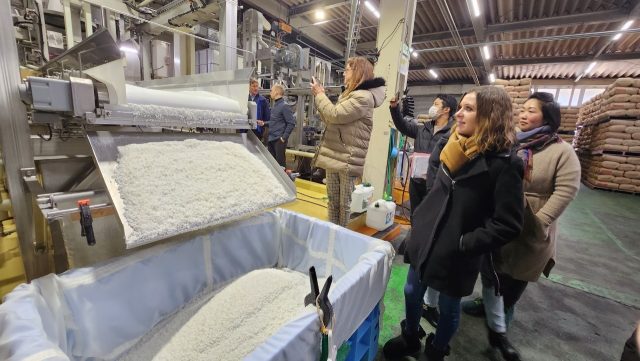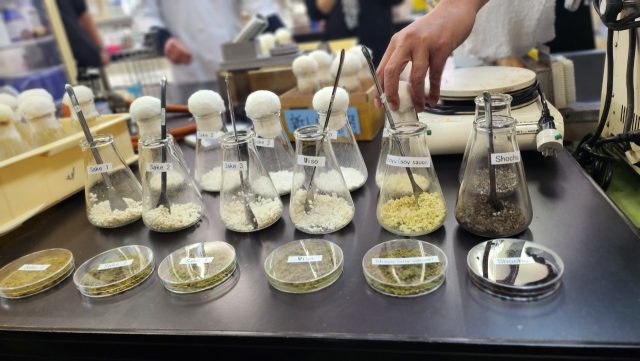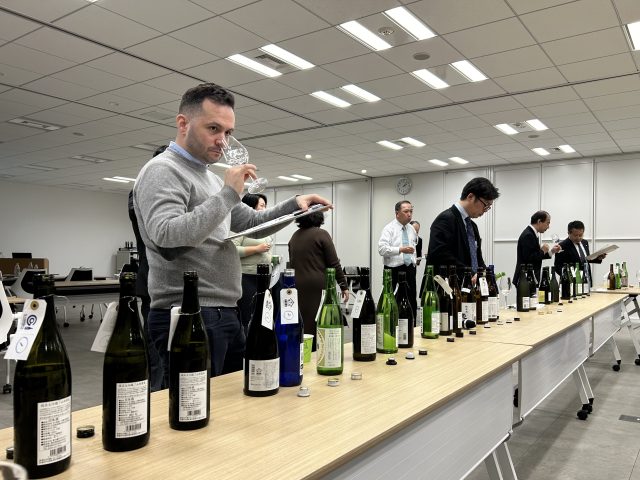This website uses cookies so that we can provide you with the best user experience possible. Cookie information is stored in your browser and performs functions such as recognising you when you return to our website and helping our team to understand which sections of the website you find most interesting and useful.
Top sommeliers journey to Japan for sake education odyssey
Leading sommeliers visited Japan this January to discover sake regions, traditional production styles and the importance of koji.

The Japan Sake and Shochu Association (JSS) kicked off 2024 by hosting five leading sommeliers on a visit to the country. The trip to Japan was part of its comprehensive strategy to advocate for sake around the world.
The JSS believes that sake is still relatively unfamiliar to people around the world, and education is crucial in increasing its recognition. To deepen the participants’ understanding of sake production methods and characteristics, the JSS organised a trip to visit authentic Japanese sake breweries, alongside a programme of tastings.
Five sommeliers from France, Spain, Lithuania, and New Zealand were carefully selected based on their experience, awards in competitions, and their active involvement in the drinks trade in their respective regions.
Sake as a product of the landscape
While Japan may appear as a small country on world maps, it spans approximately 380,000 square kilometres, similar in size to Germany, with a length from north to south of around 3,000 kilometres. Within this landmass, there are over 1,300 sake breweries and 15 designated sake geographical indication (GI) regions.
Leading up to the tour, the sommeliers conducted tastings of sake from 11 different regions. This was particularly beneficial as sake does not have a direct equivalent to the concept of terroir. Since rice is easily transported, it may be used far from the place it was grown. Rice paddies are therefore not analogous to individual vineyards, whose particular qualities may be desired by a winemaker.
However, sake does show variation according to the brewery. This is apparent in local preferences and shared techniques, but also in the use of local water. Present throughout the process, from washing rice to correcting the strength, water makes up around 80% of the end product. As such, the qualities of local water sources can profoundly influence the taste. For the sommeliers, such a broad tasting was an opportunity to pin down the connection between the local region and the finished product.
Koji: the secret behind sake making
The trip to Japan also allowed the sommeliers to explore koji. That tiny microorganism, a type of mold that measures between three and ten microns, is vital to the production of several iconic Japanese products. Sake, soy sauce and miso all require koji in their production. The seed of Koji mold is supplied by tane-koji producers , who cultivate spores for producers to use.

In the case of sake, koji is of huge importance. Indeed, it has been key to sake brewing since the 8th Century. Rice contains no sugars, and so the starch must be saccharified (turned into sugar) by koji. Unless the koji converts starch to sugar, the alcoholic fermentation cannot begin. Moreover, the koji also converts protein to amino acids, which is known to influence the flavour profile of a sake. The quality and type of koji will therefore have a strong influence on both the style and quality of sake.
In order to better understand the nuances of koji, the sommeliers visited Kojiya Sanzaemon Co. Ltd. That tane-koji producer is a prime example of Japan’s rich sake-making heritage; it has been operating for over 600 years.
Andrea Martinisi, who represented New Zealand at the ASI Best Sommelier of the World 2023 competition commented: “I really found it extremely interesting to visit the koji making factory. I loved understanding and learning how koji is made and recognizing the differences between different varieties of Koji-kin (Koji mold).”
During the tour, the sommeliers visited four sake breweries in Nagano and two in Yamanashi. One of them takes the traditional kimoto method for brewing, while another focuses on producing sparkling sake.
Kimoto is a traditional sake-producing method, once abandoned but now being rediscovered by producers. The kimoto method utilizes natural lactic acid fermentation, contributing to the complexity and lingering flavors in sake.
The sparkling sake produced using the bottled fermentation method undergoes secondary fermentation without adding sugar. Brewers remove most of the rice and koji, but leave the yeast and continue fermentation in the bottle. The sparkling sake is finally completed by removing the sake lees from the bottle.
The visit was not only a tour but also an experience pairing sake with local dishes and interacting with producers. In a particularly postcard-perfect scene, the sommeliers had the opportunity to drink warmed sake in the snow-covered rice paddies owned by one brewery.
Unlocking international sake markets
Although only six days long, the visit will have international implications, as each sommelier becomes more of an advocate for the category. Sophie Mirande, president of the Corsican Sommelier Association, for instance, stated her awe at seeing the materials and processes for sake production in person.
Meanwhile Martynas Pravilonis, who represented Lithuania at the ASI Best Sommelier in the World 2023 competition, highlighted that these kinds of educational events, as well as building relationships with sommeliers, will be key to promoting sake around the world.

Given recent export figures for sake in 2023, which saw the price per bottle hit record highs, top sommeliers may be a key route to growing markets. Indeed, sommeliers are likely to become key advocates in young markets such as South Korea and Latin America, both of which grew in value last year.
In summary, Hitoshi Utsunomiya, a director at the JSS, commented: “The JSS believes it’s crucial to communicate the correct understanding of sake and the diversity of its pairing with food directly to sommeliers, who are in direct contact with consumers, especially those representing various countries. We want them to utilise the unique characteristics of sake, which differ from wine, in their service, based on what they’ve learned on-site.”

